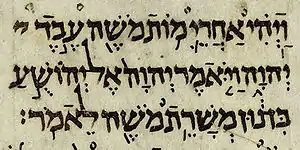Additions to Daniel
The Additions to Daniel comprise three chapters not found in the Hebrew/Aramaic text of Daniel. The text of these chapters is found in the Koine Greek Septuagint, the earliest Old Greek translation.
 | |||||
| Tanakh (Judaism) | |||||
|---|---|---|---|---|---|
|
|
|||||
| Old Testament (Christianity) | |||||
|
|
|||||
| Bible portal | |||||
In the third century CE, these additions were accepted as Scripture by all extant Christian writers except Jerome.[1] They are accepted as canonical and translated as such in Roman Catholic, Eastern Orthodox, Oriental Orthodox, and Syriac Bibles. They are listed in Article VI of the Thirty-Nine Articles of the Church of England.[2] However, most Protestant Bibles exclude these passages as biblical apocrypha, retaining only the text available today in the Hebrew/Aramaic manuscripts. In Judaism, the additions are not considered canonical, although a version of the Susanna story found its way into rabbinical literature in the Sefer Yosippon.[3]
The three additions are as follows.
- The Prayer of Azariah and Song of the Three Holy Children: Daniel 3:24–90 inserted between verses 23 and 24 in the Protestant canon (v. 24 becomes v. 91), incorporated within the Fiery Furnace episode. When Shadrach, Meshach, and Abednego are thrown into a furnace for declining to worship an idol, they are rescued by an angel and sing a song of worship.[4] In some Greek Bibles, the Prayer and the Song appear in an appendix to the book of Psalms.[5]
- Susanna and the Elders: before Daniel 1:1, a prologue in early Greek manuscripts; chapter 13 in the Vulgate. This episode, along with Bel and the Dragon, is one of "the two earliest examples" of a detective story, according to Christopher Booker. In it, two men attempt to coerce a young woman into having sexual relations with them through blackmail, but are foiled under close questioning by Daniel.[6]
- Bel and the Dragon: after Daniel 12:13 in Greek, an epilogue; chapter 14 in the Vulgate. In this tale, Daniel's detective work reveals that a brass idol believed to miraculously consume sacrifices is in fact a front for a corrupt priesthood which is stealing the offerings.[6]
References
- Alison Salvesen (2006). "The Growth of the Apocrypha". In J. W. Rogerson and Judith M. Lieu, eds., The Oxford Handbook of Biblical Studies. pp. 509.
- Article VI at episcopalian.org Archived 2007-09-28 at the Wayback Machine
- Alison Salvesen (2006). "The Growth of the Apocrypha". In J. W. Rogerson and Judith M. Lieu, eds., The Oxford Handbook of Biblical Studies. pp. 508–509.
- Emil Schürer (1987 edition). Edited by Géza Vermes et al. The History of the Jewish People in the Age of Jesus Christ, Vol. III, Part 2. Pages 722–730.
- James C. VanderKam (2001), An Introduction to Early Judaism. Eerdmans. p. 133.
- Christopher Book (2004), The Seven Basic Plots, pages 505–506
Further reading
- R. H. Charles, ed. (2004 [1913]). The Apocrypha and Pseudepigrapha of the Old Testament. Volume I: Apocrypha. Originally by Clarendon Press, 2004 edition by The Apocryphile Press. pp. 625–664.
- J. C. Dancy, ed. (1972). The Shorter Books of the Apocrypha. The Cambridge Bible Commentary on the New English Bible. pp. 210–241.
- Alison Salvesen (2006). "The Growth of the Apocrypha". In J. W. Rogerson and Judith M. Lieu, eds., The Oxford Handbook of Biblical Studies. pp. 508–509.
External links
- NRSV: Prayer of Azariah
- NRSV: Susanna
- NRSV: Bel and the Dragon
- Daniel (including Azariah and the Song), Sousanna, Bel and the Dragon in the New English Translation of the Septuagint.
 Additions to Daniel public domain audiobook at LibriVox
Additions to Daniel public domain audiobook at LibriVox
